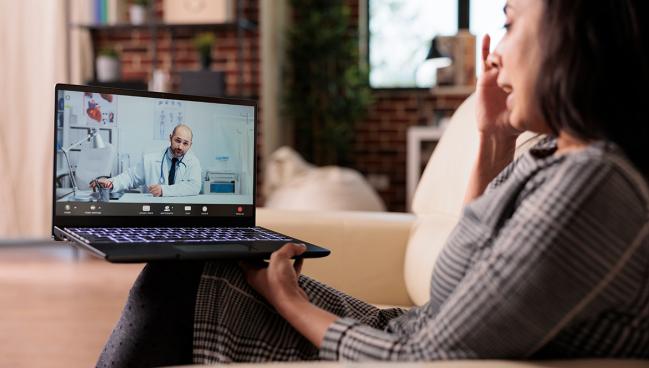AHA Statement Stresses Importance of Telehealth in CVD Care
With ongoing challenges related to reimbursement, access, and acceptance, the writing committee offers potential solutions.

Stressing the importance of telehealth in cardiovascular care, especially given its increased prevalence during the COVID-19 pandemic, a new scientific statement from the American Heart Association (AHA) outlines the current barriers to this type of care and offers some strategies for continued access.
As in-person visits were shut down in the spring of 2020, many clinicians and patients turned to telehealth, with subsequent studies and surveys showing related gains in heart failure and nonemergent cardiovascular care. Other research showed that patients who were more likely to use telehealth tended to be younger and privately insured, have more comorbidities, and be from underrepresented racial/ethnic groups.
As the pandemic has waned, however, reimbursement for telephone and video visits has been a larger concern. Earlier this month, the US Centers for Medicare & Medicaid Services (CMS) released its 2023 Physician Fee Schedule, which includes continued coverage for telehealth, but only for 5 months following the end of the public health emergency, which some say is not long enough for clinicians to make long-term plans and invest in necessary infrastructure.
“This paper in a way summarizes the importance of telehealth and the benefits of telehealth in patient care,” writing committee chair Edwin A. Takahashi, MD (Mayo Clinic, Rochester, MN), told TCTMD. “Payment parity is so important in sustaining telehealth. So I hope that CMS and insurance companies will see the importance highlighted in this paper and reconsider their reimbursement plans with it.”
What Is Telehealth?
The statement, published online this week in Circulation, begins by defining the concept of telehealth, breaking it down into clinician-to-patient visits and clinician-to-clinician consults. The former includes real-time virtual visits, either video or audio, as well as digital communication, called eVisits, initiated by either the physician or patient. The latter includes both real-time virtual consults, which may also include the patient, as well as digital exchange of low-complexity medical information between clinicians, called eConsults, or second opinions on more-complex concerns. A final hybrid category includes remote monitoring for patients and predictive analysis for clinicians—both machine initiated.
Takahashi and colleagues point out some commonly used telehealth tools for cardiovascular home monitoring, including machines for monitoring risk factors like blood pressure, weight, smoking, and diet; medication tracking apps and smart pillboxes for managing medication adherence; and tools like home EGC, pulse oximeter, and pulmonary artery pressure monitoring devices.
While there are an undefined number of ways in which telehealth can be useful within cardiovascular care, Takahashi said it’s most effective in tracking disease progression for heart failure and CAD, improving stroke outcomes by decreasing time to diagnosis, and monitoring PAD progression, as well as preventing ulcers and tracking patients postoperatively.
The paper outlines advances in telestroke, teleradiology, and telehealth in PAD management.
Challenges and Potential Solutions
Many challenges remain in order for telehealth to flourish in a nonpandemic era.
In his experience, Takahashi said, the biggest barrier to using telehealth relates to “having patients accept it as a replacement for inpatient visits.” But overall, challenges like infrastructure—including broadband internet and hardware for patients—to complete telehealth visits as well as reimbursement stand in the way of telehealth use more generally, he said. “In order for people to adopt and use telehealth, people need to be able to bill for using it. Otherwise, it just is not sustainable.”
The statement also stresses the importance that clinician attitude, biases, and acceptance play in the success of telehealth. Difficult to use technological platforms hindered by HIPAA-compliant encryption can also make it more difficult for clinicians to access telehealth appointments.
Beyond increases in reimbursement for telehealth, the authors propose a few strategies for continued success. They advocate for government programs to improve broadband internet access across the country, more research to elucidate the specific benefits telehealth can have across the spectrum of cardiovascular disease care, and increased standardization for methods in assessing telehealth quality.
“The COVID-19 pandemic improved the telehealth infrastructure through necessity but also uncovered systemic weakness, limitations, and inequities,” they conclude. “Further research into barriers for telehealth implementation and equitable execution are important to ensure the delivery of high-quality care for patients.”
Yael L. Maxwell is Senior Medical Journalist for TCTMD and Section Editor of TCTMD's Fellows Forum. She served as the inaugural…
Read Full BioSources
Takahashi EA, Schwamm LH, Adeoye OM, et al. An overview of telehealth in the management of cardiovascular disease: a scientific statement from the American Heart Association. Circulation. 2022;Epub ahead of print.
Disclosures
- Takahashi reports no relevant conflicts of interest.





Comments